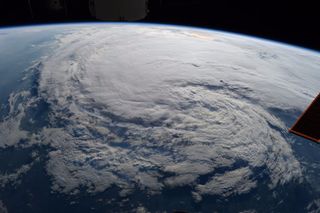As Flooding from Harvey Intensifies, Astronauts Tweet Well Wishes to Houston

Astronauts on the International Space Station have been sending well wishes to their friends, family and colleagues in Houston, as the city and surrounding areas continue to deal with massive flooding caused by Tropical Storm Harvey.
Earlier this afternoon (Aug. 28), NASA astronaut Randy Bresnik — who is currently on the International Space Station — tweeted that Harvey was "still a menace! Hearts & prayers go out to families, friends, & fellow Texans dealing with this storm. #TexasStrong #HoustonStrong."
Harvey struck the southeast coast of Texas on Friday night (Aug. 25) as a Category 4 hurricane. Although it was downgraded to a tropical storm shortly after making landfall, Harvey has drenched that area, and much of southern Louisiana, with record-setting amounts of rain. Eight deaths have now been reported as a result of the storm, with as many as 30,000 people expected to leave the area due to flooding. [How to Donate to Harvey Victims Online]
NASA astronaut Jack Fischer, who is also on the space station, tweeted that the station crew's "thoughts & prayers are with folks feeling Harvey’s wrath."
NASA has closed its Johnson Space Center (JSC) in Houston — home to mission control, which is responsible for NASA's operation of the International Space Station — to all but mission-critical employees due to the flooding.
JSC is also where the James Webb Space Telescope (JWST), set to launch in late 2018, is currently being stored. NASA tweeted earlier that the telescope is fine, although the facility seems to be experiencing some flooding: Sarah Kendrew, a member of the JWST mission office, tweeted from Houston that staff members are "having to use mops & buckets" around the cryo chamber where the telescope is stored, but she noted that "the telescope is totally fine." (Kendrew's tweets are those of an individual, and not an official statement from the agency.)
Kendrew, an astronomer and instrument scientist working for the European Space Agency (which is a collaborator on Webb), also tweeted that the day had been filled with "relentless, torrential rain," that "hasn't eased for a minute since 7 am." She said displaced people were arriving at her hotel including "many elderly and with kids," and that the "staff [have] not been able to reach home in days. Dreadful."
Sign up for the Live Science daily newsletter now
Get the world’s most fascinating discoveries delivered straight to your inbox.
Satellites have been tracking the storm's progress since last week as well. The National Oceanic and Atmospheric Administration (NOAA)/NASA GOES-16 satellite captured incredible, high-resolution footage (shown in the image above) of the storm as it approached landfall on Aug. 25. The NOAA/NASA GOES East satellite has provided precipitation data, along with the Global Precipitation Measurement core observatory satellite (a partnership between the Japan Aerospace Exploration Agency and NASA), and NASA's Aqua satellite. The European Space Agency (ESA) is watching Harvey with its Copernicus Sentinel-3A satellite.
ESA also issued a tweet to JSC regarding the dangerous conditions around the facility, saying simply, "Stay safe, everyone."
Follow Calla Cofield @callacofield.Follow us @Spacedotcom, Facebook and Google+. Original article on Space.com.
Most Popular



